The busier we get, the faster the seasons seem to fly by. I’m sure that in mid-summer there used to be a lull, a time to sit back, relax, and enjoy the results of the spring planting rush. Between goat shows, professional conferences, and various other distractions though, this year we seem to have skipped the ‘relaxation’ part, and now fall planting is already upon us! Not to mention that as of last week, the Curbstone Valley Farm blog turned 3 years old! Where does the time go?
Native Garden
We could almost set our watches by the native plant bloom cycles here. The end of July to early August is where most of the native plants around the gardens are rushing headlong into dormancy. This is also the time of year we start to plan what to plant in the native gardens, as prime planting season is in the autumn here.
Of the remaining spring blooms, the sages are still managing to push a few new flowers, especially the late season bloomer, ‘Winnifred Gilman’.

Salvia clevelandii ‘Winnifred Gilman’ is the darkest colored of the native sages growing here, but not the hardiest
I’ve now succeeded in killing three of these, but also have five of them that seem to be holding up. I’m a bit of a miser on the watering-front, so those losses were my fault. However, I am convinced, at least here, this cultivar is simply not as robust, or reliable, as either ‘Pozo Blue’, or ‘Alan Chickering’.
Not all the native flowers are done for the season though. A few late summer native bloomers do thrive during this warm and dry period, including the vibrant California Fuschias (Zauchneria sp.), which are just starting to bloom, and the Asters that grow wild all over the property.
I’m not sure why, but this year seems to be a particularly good year for the Asters, and there are numerous clumps that have popped up around the edges of the vegetable garden, perhaps due to the extra moisture in the soil in the cultivated areas.
Regardless, the skippers, and bees seem to love them, and with flowers becoming somewhat scarce here at the moment, their cheery blooms are very welcome.
Herbs and Flowers
Of course, there are still some blooms to be found in the herb garden, including this ever-growing fennel that we left for the pollinators to enjoy.
I’m actually curious now to see just how tall it can get. It’s already over 8 feet in height!
Bees can be found buzzing around the flowers all day long, but at the moment their favorite is the oregano that started to bloom in the last couple of weeks, and certainly an herb we should consider planting more of here, as it blooms now, after the majority of native flowers fade.
A new addition to the herb garden this year is Sweet Mace (Tagetes lucida).
Apparently the leaves of this plant are used to make a pesto, especially in the southern United States. Always eager to try something new in the kitchen, and unable to find it anywhere else, I decided we’d grow our own. I’m curious to see how such a pesto would taste, but I need to wait a few more weeks for these plants to mature.
As they tend to take over, this year we’ve planted a lot of Nasturtiums in containers.
These edible flowers bring a fun splash of color, both to the garden, and to summer salads.
We didn’t plant any sunflowers in the garden this year, well, not intentionally. We’ve learned we can’t direct sow them here with much success, as the voles gnaw through the stems while they’re young. That said though, we have had a few volunteers that have survived the clutches of our resident rodents.
This appears to be a cross from last year’s heirloom sunflowers that we planted.
There’s just a faint hint of the rust color on the petal margin of these flowers that was present on the ‘Autumn Beauty’ sunflowers last year. This particular sunflower plant is a poly-headed variety, and has no less than NINE blooms on a single plant at the moment. Regardless as to what specifically this may be, the flowers are very much loved by all the pollinators that visit them.
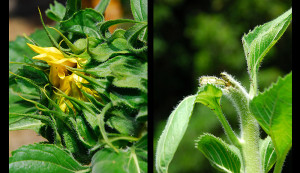
Earlier this season though, this sunflower was vandalized. Something absconded with its head (we’re suspecting squirrels).
Vegetable Garden
In the vegetable gardens, after two unseasonably cold, and foggy, summers in a row, where we seemed to spend more time whining about the weather, than actually harvesting fruits, this year the weather has been much more conducive to growing heat-loving plants.
The tomatoes, although planted a little late with our schedule this spring, and slowed down somewhat by our first foray into grafting, have really taken off.
They’re setting lots of fruit, and providing we can keep the woodland creatures off them, we should be harvesting plenty of fruits throughout the remainder of summer.
Well, except for ‘Blondkopfchen’.
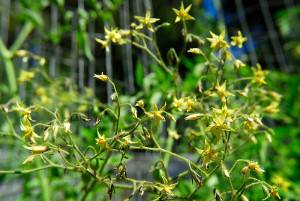
Blondkopfchen, at least here, seems to produce ample blooms, but struggles to set fruit with our cool nighttime temperatures
Again this year, this variety is struggling to set fruit. Our nighttime temperatures are still frequently below 50 degrees, and of all the varieties of tomatoes growing here, this one seems to resent cold coastal nights the most.
Although fruit-set has been much better this year, we did lose most of the initial early crop of ‘Stupice’ this year, as well as ‘Crnkovic Yugoslavian’, to rodents.
The downside of trying to grow food at the edge of a woodland is that rodents, in various shapes and sizes, abound. They’re always willing to take produce from the garden long before we would, and as we don’t bait here, again, we’ve resorted to trapping for voles and rats.
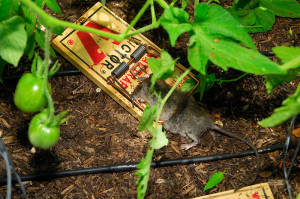
We set numerous traps, which need to be checked, and reset daily. Trapping is labor intensive, but much safer than using bait (don’t enlarge image if you’re squeamish)
We do seem to be seeing some difference in overall plant health between the tomatoes we grafted, and those we sowed conventionally, but in regards to yields and overall vigor, it’s still too early to tell how much better our grafts will perform. We’ll update more as the season progresses though.
The tomatillos this season are producing masses of fruits again, and just in time too, as we’re down to our last jar of tomatillo salsa verde from last year. We’re looking forward to restocking the pantry with salsa very soon. It was too good not to make again!
Before we ramped up our rodent-trapping in the garden, we also lost a number of beautiful baby eggplant fruits. This is the first year we’ve grown eggplant here. The last two years probably would have been a disaster if we’d tried, as eggplants want warm soils. However, this year we seem to be having a run of beginner’s luck, most likely due to our improved weather.
Although the rodents gnawed some young fruits in the early season, the plants themselves were left alone (which is more than I can say for our beans), and this year may prove to be the ‘year of the eggplant’ here at Curbstone Valley.
Not being particularly fond of the classic large Aubergine’s, instead we’re growing a few assorted smaller eggplant varieties, so we’re not inundated with too much eggplant all at once.
Thus far, our favorite is the ‘Long Purple’ Eggplant.
The plants are gorgeous, with stunning blooms.
The leaves are gorgeous, and the fruits are sweet, and tender, and grill absolutely beautifully, with no bitter aftertaste.
These smaller ‘Little Fingers’ are prolific too, and as tender as they are beautiful.
The larger ‘Rosa Bianca’ though is absolutely stunning, with its lovely lavender purple fruits, mixed with white.
I’ve had my eye on this one for some time, which is almost ready to harvest, and we can’t wait to see how this tastes…grilled, with a little olive oil and salt.
The most anticipated eggplant growing in the garden though, is this!
No, it’s not a tomato, I promise.
This is ‘Turkish Orange’, and not your typical looking eggplant. Unfortunately, the rodents sampled a few of the early fruits, long before they had any color. We removed those fruits, and now we have these beauties that are just about ready to harvest. I have read they can be slightly bitter, but hopefully we’ll get to try these for ourselves in the next few days. Regardless, they certainly stand out in the garden!
Giving the eggplants a run for their money, the peppers are no slouches this season either.
There’s no question we’re having our best pepper year ever here.
Part of that is no doubt due to the warmer weather, but it seems that part of it is also a result of soil improvement. As we continue to amend our raised bed soils with compost, our soil structure has improved tremendously. As our native soils were so poor, we had to bring outside soil in for the beds, but it needed…work. Fortunately, between the chickens, turkeys, and goats, we’re not short of compostable material here, and the results for us are very noticeable.
The bell peppers this year, including ‘Purple Beauty’, ‘Orange Bell’, and Golden Cal Wonder’, are producing beautiful healthy large fruits.
The first year, comparatively, our pepper plants seemed almost stunted.
New to this year’s garden is both yellow, and red, ‘Corno di Toro’ (Bull’s Horn) peppers.
So far, the yields seem superior to ‘Lipstick’, and ‘Quadrato D’asti Rosso’ that we’ve grown previously, so we’ll be interested to see how this variety performs throughout this summer season.
Somewhat less successful, at least so far this season, are the cucumbers. Early in the season, before the vines had gained much height, many of the early fruits were stolen from the vines.
Occasionally we’d find remnants with teeth marks in them, which would usually cause me mumble a few expletives that would even make Gordon Ramsay’s toes curl. However, now the vines are tall enough to trellis them up off the ground, the fruits seem to be surviving much better. At the moment ‘Lemon Cuke’ is producing a lot of moderately sized globes.
What we’ve learned this season though, is for us, we need to avoid ‘bush-type’ varieties, and commit to trellising our cukes if we want to actually harvest any fruit.
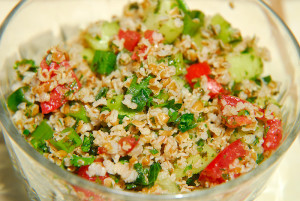
Despite a few losses in the garden, when you have cucumbers, tomatoes, parsley, and mint growing in the garden, Tabbouleh is great way to use them all.
This is just an example of the level of damage to the garden this year. We grafted 20 different varieties of heirloom pomme fruits this spring. All but 11 trees were killed outright as a result of having their leaves and/or bark stripped.
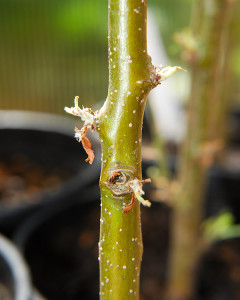
Every single one of this spring’s grafted apples were defoliated over the period of a few nights. This time we suspect a rogue rabbit.
These poor hapless grafted trees should be getting transferred to 5 gallon containers about now, but sadly, due to the damage to these plants, it’s not clear if any of these will be thriving by year’s end.
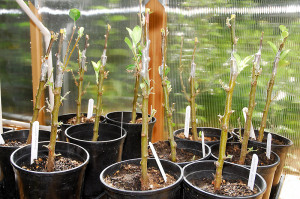
We’ve moved the grafted apples back into the greenhouse, where we hope they’re safer. Although I forgot to mention the vole I had to chase out of the greenhouse recently.
We’re just not sure how much of this is voles/rats, versus possibly a rogue rabbit, so the rabbit live-trap is out to see if we can answer that question once and for all.

This bean leaf is too far off the ground to have been chewed on by rats or voles. More likely squirrels or rabbits.
There are days I’ve been tempted to take down our ‘Certified Wildlife Habitat’ sign. When you lose produce almost as fast as you can grow it, it really starts to take the joy out of gardening.
For now we’ve left the sign up, but we did scale back the squash planting this year, significantly, primarily to avoid providing too much cover for the meadow voles, that have been officially nominated as THE most destructive rodents on the property (sorry squirrels, you came in second).
So far, unlike last year, the voles seem to be leaving the plants alone, but it’s still early yet, so we’ll have to wait and see.
As robust as the summer garden is, we’re also in the midst of fall planting. We’ve uprooted the last of the summer crop of potatoes, and will save some of these for our late season fall crop.
Kale, spinach, tatsoi,and chard have been planted out on the shadier side of the garden in the last week.
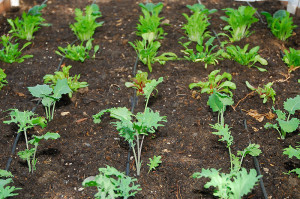
A late warm spell may cause the kale to bolt, but on the shady side of the garden we can usually plant a late summer crop
In an adjacent bed, a new crop of assorted lettuces.
Carrots will be hitting the dirt this next week, along with some beautiful Chinese Red Meat radishes, and beets.
Orchard
In the meantime, in the orchard, the ‘Frost Peach’ tree suddenly has a bounty of fruit that is ready to harvest, and the ‘Indian Free’ peaches are just starting to turn. We’ll eat some fresh, but no doubt turn a few at least into peach jam.
Our very first, albeit small, harvest of the exceptionally sweet dessert pear ‘Seckle’ seems imminent…
…and we’re still harvesting a few Pluots too.
What we’re really looking forward to though, is the apple harvest!
With so much growing in the garden, we still have a lot to look forward to throughout the remainder of the growing season. Before long, the kitchen will shift from canning and freezing summer produce, to infusing the air with the scent of cinnamon and apples. Pie, anyone?

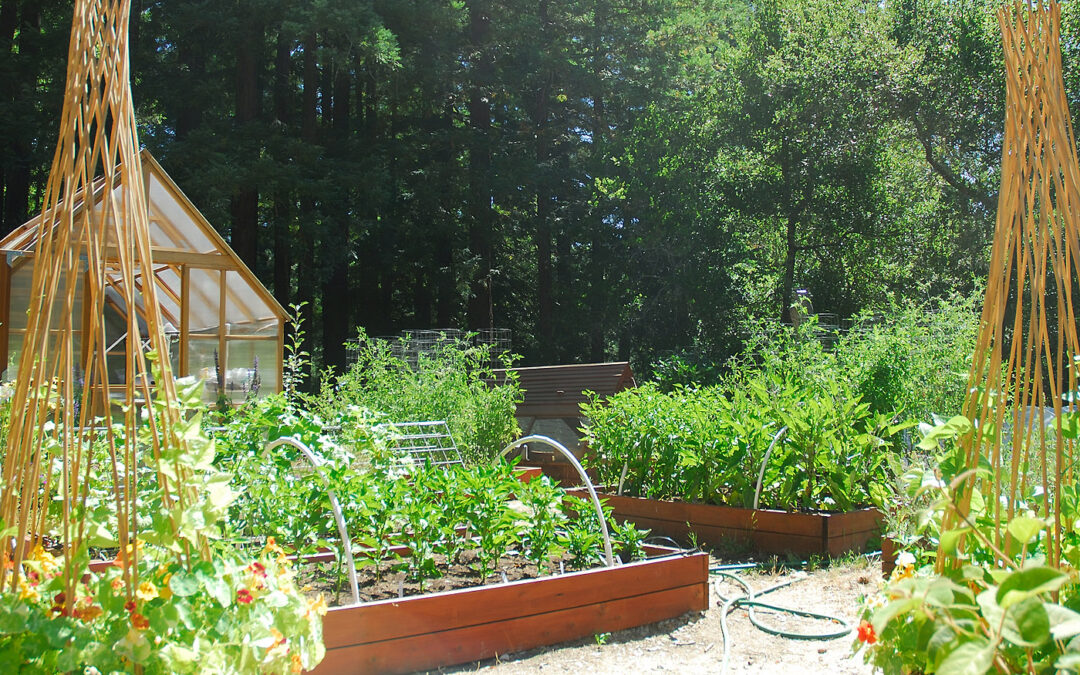
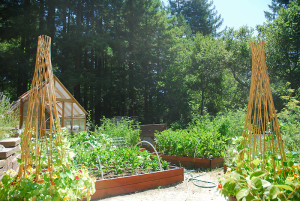

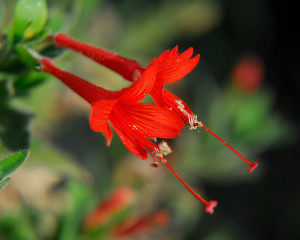
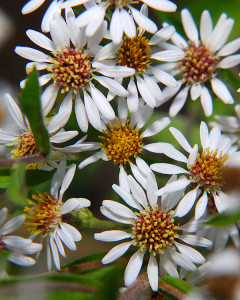

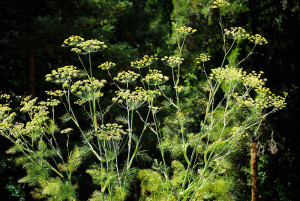
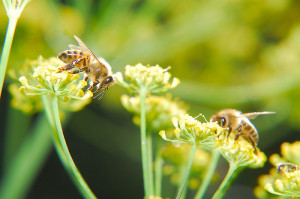
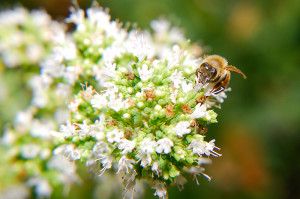
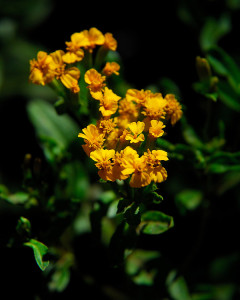



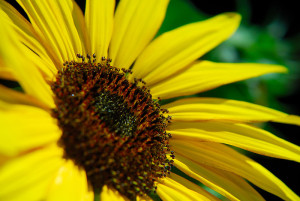
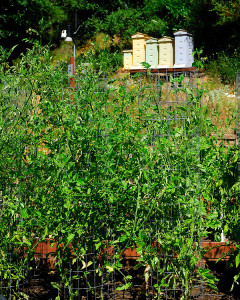
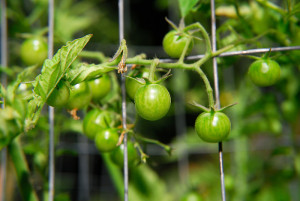
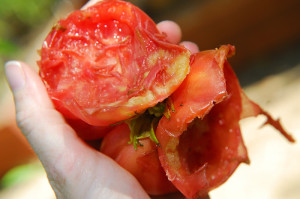
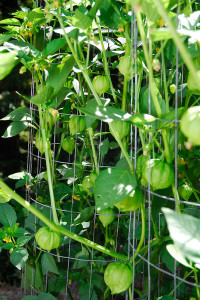
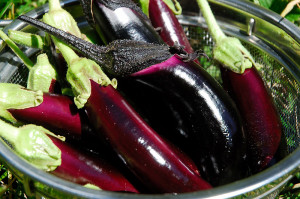
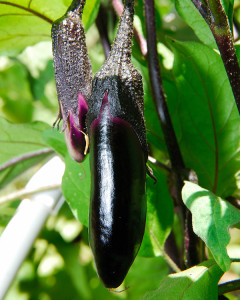
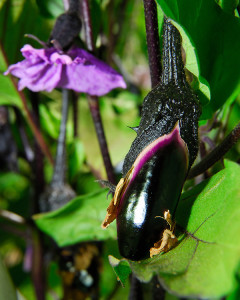
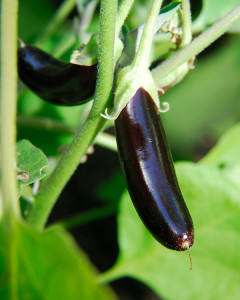
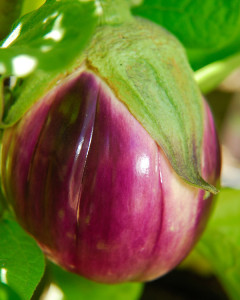
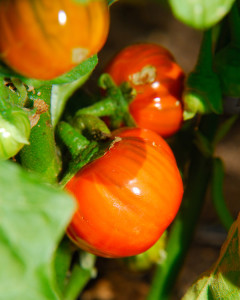
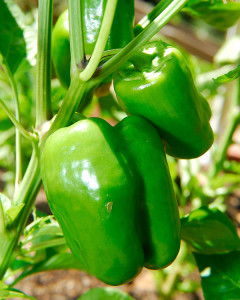
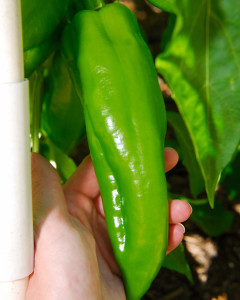

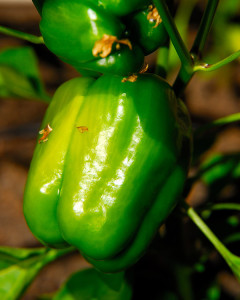
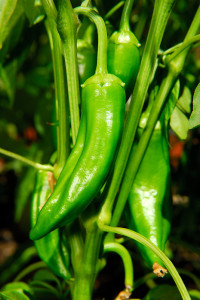
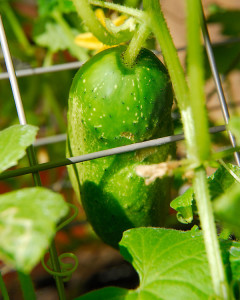
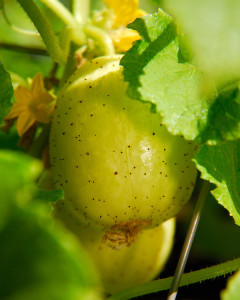


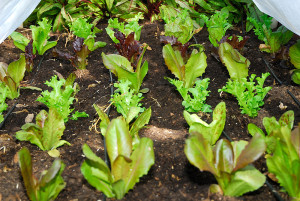



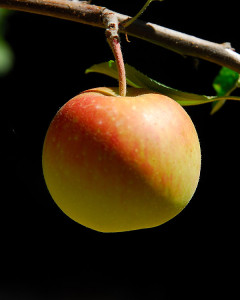







Clare,
Seems so busy there this time of year! Down in the 50s at night, we feel lucky when it drops into the 70s this time of year. Lemon cukes are my favorite, pick them just over golf ball size for the best taste. You sure have a lot of egg plants!!
It seems that nights over 55F are rare these days. I shouldn’t complain though. The daytime high was 95F yesterday, but it cooled to 52F overnight once the marine layer pushed in along the coast. At least we don’t need air conditioning 😉
I admire all your great veggies, and I love the photo showing the larger view of your kitchen garden! I have never grown an eggplant, but your beauties, especially Rosa Bianca, make me think again! All of your hard work is certainly rewarding, though I feel your frustration over the damage done by voles and other critters. I hope your apples will rebound and become beautiful, productive trees.
I’m crossing my fingers that the apples will recover, although the rotten rodents took out my favorite variety, the Niedzwetzkyana crab apple (we’d grafted two, and they destroyed both of them). Oh well, it’s an excuse to attend the scion exchange again next year!
Your eggplant photos are making me jealous! BTW, I’ve read that ‘Turkish Orange’ is best harvested when it just starts getting some orange color, but haven’t grown it myself to verify.
I’ll have to try it both ways. We have quite a few green ones the plant still, so I can harvest a few early, and see if that influences the flavor. Thanks for the tip!
The long purple eggplants are definitely cool to look at. I appreciate eggplant’s ‘ornamental’ qualities but will leave the eating to my wife.
The are pretty, and the plants themselves, especially ‘Long Purple’, are very ornamental in appearance. I was never a big fan of eggplant, but I often was served it overcooked. I find the smaller Japanese-type eggplants have a much less mushier texture. Besides, unless you’re making something like eggplant parmigiana, it can be challenging to use a whole one of the large variety!
How amazing to see your bountiful harvest – something I have not tried is the eggplant – how gorgeous is yours? I can’t wait for my small veg garden to produce all the yummies !!
If you have a small space, these smaller eggplants are very productive for their size. I’m definitely going to grow them again. Their texture is so much better when they come straight from the garden!
Where does the time go indeed! There has been little rest here of late for sure. Our bees seem to be loving oregano and thyme, but not so much the fennel or lavender this year. I guess they are opportunistic, and go wherever they think is best, and who am I to tell a honeybee what to do?
Our cukes have been ravaged by the hungry deer this year. I’ve never had to protect them before, so I guess they were easy pickings for the hungry whitetails. At least now that it has cooled down the ones in the greenhouse have started bearing again, so we will have a few! And birds have been pecking at the ripe tomatoes, but at least they leave most of the tomato for us – unlike whatever ate yours completely! It is always something.
Those are some lovely eggplants and peppers!
Our bees will certainly take oregano over lavender, but until a couple of weeks ago, I think they were just ‘making do’ with the lavender blooms. I’m sure they must have preference for the highest nectar-reward blooms available. I’m sorry to hear about the deer and your cukes. Mine seem to be contenting themselves with eating my deer-resistant milkweeds, probably out of spite, as they can’t get in the vegetable garden! 😛
It’s so interesting to see how gardens grow in different parts of the country. Here in zone 8B, I’m preparing to plant a second summer garden with a limited number of winter veggies. It’s still very hot! Your sunflowers may have been beheaded by a deer. I know around here the deer love my sunflowers.
As soon as I transplanted the kale, our temperatures shot up into the 90’s…of course. Fortunately, the winter greens are on a shady side of the garden. I would have suspected deer as sunflower snatchers, but that sunflower was actually growing in the orchard, inside the deer fence. One of these days I’m going to spring for one of those night-vision garden video cameras, so I can see some proof of who’s raiding the garden at night! 😉
What beautiful eggplants! I’ve never seen – or even heard of – an orange eggplant! I grew white ones last year. I liked their taste much more than the purple ones, which seem a bit bitter to me at times. I am trying to imagine the taste of the orange eggplant. A bit sweet, perhaps? Your peppers are impressive, too!
The orange eggplant was new to me too! I haven’t tried the orange eggplant, but am going to grill one this evening and see how the flavor is. I may try one of the white varieties next year, just for some variety!
Clare I am always exhausted reading your posts as you put me to shame with the work you do…your harvest is amazing and you take the critter damage in stride, I love the herbs in flower and it does not look like a good year for aster for me. There may be none sadly. Waiting for a cool down so I can get to the big projects this fall.
Ha! Well, I admit this post was a little long. We hadn’t posted anything in the last month while we moved our ‘forever-getting-hacked’ blog to a new web host. The transfer was a little more painful than I would have liked, but worth it for the increased security. I suspect with the excessive heat throughout much of the country that the fall blooms, and fall foliage, will be a bit different this year for many. Our garden just seems to be relieved to be above the fog belt for the first time in the last two years!
Wildflowers here are just starting to really bloom. It is so different across the country in what is blooming. The bees have daily favorites, I noticed that in my small garden. But you have much better choices for them. The fruit looks yummy. I did not realize the squirrels would damage the apples. I put fruit out for the birds and the squirrels leave it alone. Yesterday was banana and orange slices. I will have to see what the squirrels do with apple.
Our wildflower season is usually late winter through early summer. This weekend we’ll need to re-install the robbing screens on the bee hives, as most of the wild nectar sources have dried up, and the colonies will start to prey on weaker hives to steal their stores. I’m not sure if it’s squirrels or bunnies that are wreaking havoc on the apple trees…I’m hoping to have my answer very soon. I’m starting to lean toward rabbits, as this morning an entire, quite large, parsley plant is completely missing! 😯
I am so with you on the “seasons seem to be flying by”. I’m not even sure where the month of July went. Not to mention August is nearly half over. Your harvest looks delightful Clare.
I can’t believe I’m already thinking about ordering garlic for the fall planting season. I’m afraid October will be here before we know it!
I don’t know where to start, you’ve got so much going on. First of all, Happy Blogversary. Three years, well done and thanks for sharing your slice of heaven with us all.
Love that California Fuschia and those native Asters are simply beautiful! 8-foot tall Fennel is simply amazing!! I usually grow Naturtium ‘Alaska’ every year too, but missed this year. You’ve reminded me just how lovely that plant is, so I will definitely have to add some next year.
Orange Eggplants? That was something new for me. Sounds fabulous. Those dreadful creatures seem to be causing lots of damage to your vegie yield. At least the fruit seems to be escaping critter attention.
I don’t mind sharing a little of the harvest, but this year the rodents don’t seem to be willing to share with us! So far though, all I’ve caught in the live trap I set for the bunnies, is a squirrel! Oh well, hopefully soon there’ll be such a bounty in the garden, there will be enough for all of us 😉
Oh, so good to hear from you! Lots going on for sure. Too bad about the rodents – we have a problem with crows which seem to decimate the songbird population and poop everywhere. And you can’t even trap them.
For the fruit, netting really helped us but it’s a lot of work and only practical for small trees.
Enjoy the apples!
Except for the blueberries and cherries, the birds and rodents so far have mostly left the fruit alone. I did look into some of the commercial scale netting that wineries use to protect their grape crops. If it becomes a problem here I may try using that. We have our first Spitzenburg apples on the tree this summer, and I can’t wait to try them!
Your garden looks incredible! Love all the different types of produce. Traps are old school but highly effective. We had mice invade out basement last winter and resorted to claw-type traps to catch them. I hope this solves your rodent problem.
Traps may not ‘solve’ the problem, but I’m hoping they at least stop the problem from getting completely out of hand. We don’t want the rodents to be too well fed 😉
Clare, I know what you mean about the summer just zipping by. It’s interesting that so many of your food crops are the same ones that I’ve been enjoying from my CSA in Maine. We’ve had tons of basil (with another batch of pesto on tap for today), eggplant, some tomatoes, many pounds of potatoes, and the cucumber harvest has just taken off (including some of those cute lemon cukes). I used to have a neighbor who kept honeybees; and as soon as my oregano bloomed, they would appear in large numbers in my garden. (I always wondered if he marketed “oregano honey.” :-))
The bees really do seem to favor the oregano here. It’s actually a very pretty herb in the garden, so I’m thinking of moving a few things around so we can plant a lot of more of it next spring!
Lovely to catch up with Curbstone Valley – now it and I am back in the land of blogging. What a land of milk and honey you live in – minus the odd rodent, cougar etc Not fond of eggplants but the smaller purple fingers look just right
p.s. judging by the charmingly cute goat posts, you could be a scriptwirter.
p.p.s hope Frodo and the girls are enjoying this fly-past summer
Well, once the goaties start producing milk, I suppose with the bees, we really will live in a land of milk of honey! 😛 Glad to see you back in the blogging world! Frodo and the girls are doing great, although they look a little ratty at the moment as they’re starting to molt! 😉
Despite the predation, I envy your harvest. I have to physically leave my garden to have down time. It is interesting that you say that fall is the prime planting time where you are. Do the local nurseries stock up for fall? With our summer droughts I think fall planting makes much more sense.
Fall is the prime planting season for our California native plants. Many of our natives are dormant in summer, but quickly bounce back to life once the fall rains return. By planting our natives in the fall, they can become well established over the winter, without much need for supplemental irrigation (last winter was an exception as it was so dry). Then come late winter to early spring, they’re all in bloom. Spring planting for natives here is dicey. If our spring rains stop early, the plants may struggle through the summer dry season.
Your garden is looking fantastic! I can’t wait for summer here… I will definitely be following your lead this year and putting in more flowering plants. We had a few last year, and with grape vines close by there are bees around once they set fruit, but I think having extras will really help in the garden – and look great. I like your idea of planting nasturtiums in pots to stop them taking over completely.
I’m finding that the more I can work flowering plants, like the Mace or Marigold, Nasturtium or Borage, into the ends of the beds, the more I can entice the pollinators, and potential predators, into the garden beds. That all translates into lest pest control!